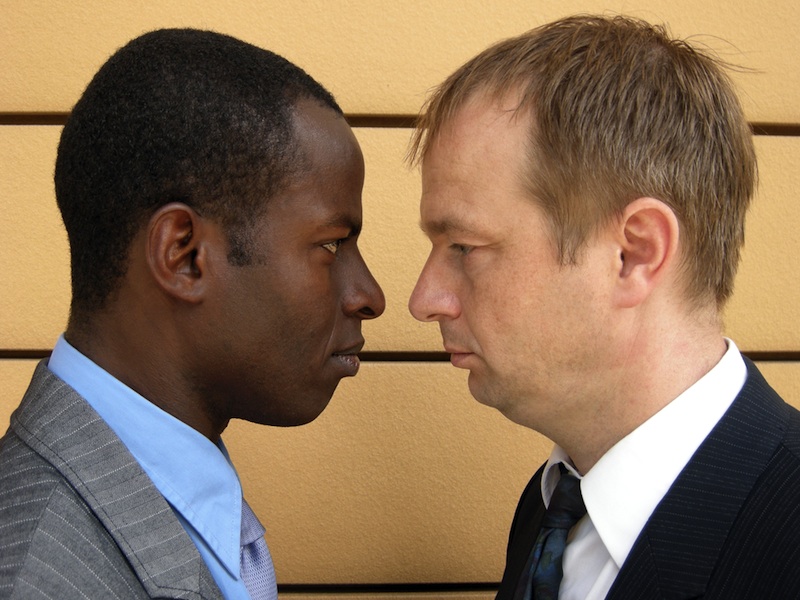Weird Skin Color Illusion Can Reduce Racism

Here's a novel way to reduce racism: Convince people their skin is darker than it really is.
No need to break out the tanning booth. A new study finds that an illusion that makes people feel that a rubber hand is their own can make white people less unconsciously biased against people with dark skin.
"It comes down to a perceived similarity between white and dark skin," study researcher Lara Maister, a psychologist at Royal Holloway University of London, said in a statement. "The illusion creates an overlap, which in turn helps to reduce negative attitudes because participants see less difference between themselves and those with dark skin."
The rubber hand illusion is a classic psychology experiment in which a participant sits at a table with his or her hand obscured by a screen. A rubber hand is placed parallel to the person's own hand, where the participant can see it. By stroking or touching the fake hand and the person's real hand at the same time, a psychologist can make the participant feel like the hand is part of their body. [10 Things That Make Humans Special]
Race and the rubber hand
Maister and her colleagues wanted to know if using a rubber hand in a dark skin tone might influence the way white people perceived race. Previous studies have found that people's brains activate to mirror actions they watch other people doing; this effect is stronger when a person is watching someone of his or her own race and weakens when they see someone of another race.
Perhaps, the researchers thought, if people came to see a limb with darker skin as their own, they might perceive more overlap between themselves and someone of another race. To test the idea, they first recruited 34 Caucasian students to take part in the rubber hand illusion.
Sign up for the Live Science daily newsletter now
Get the world’s most fascinating discoveries delivered straight to your inbox.
Because racism is generally frowned upon, psychologists can't always trust participants to be upfront about (or even aware of) their biases in questionnaires. To get around the problem, the researchers tested their participants' implicit racial biases. The volunteers were shown negative words, positive words and dark-skinned faces separately on a computer screen. They had to categorize the words as either "good" or "bad" by pressing a computer key.
The participants also had to categorize the faces as "dark" by pressing a computer key. In some cases, that key was the same one used to mark good words. In other cases, the "dark" key was the same as the one used to flag bad words.
Those who are more racially biased are quicker at flagging dark faces and bad words when the key for each is the same, and stumble more when they have to associate "dark" with "good." It's a difficult test to fool, given that it relies on millisecond-long delays and minor errors that are tough to correct for.
Reducing racism
After a few rounds of the implicit test to establish a baseline, the participants underwent the rubber hand illusion for two minutes with a dark-skinned rubber limb. Afterward, they were asked how strongly they felt the false hand was their own. Then they took the implicit racial bias test again.
The results revealed that the stronger the feeling of ownership over the dark-skinned hand, the less racially biased the participant was in the second test — regardless of their scores on round one.
In a second experiment, 69 more white participants completed the same tasks, but this time, some did the rubber hand illusion with a white hand and some with a dark hand. Again, ownership over the dark-skinned hand led to less racial bias, while ownership over the light-skinned hand changed nothing. The researchers reported their findings today (May 14) in the journal Cognition.
The researchers aren't sure how the experiment would work if dark-skinned individuals were made to feel a white hand was their own; the implicit racial bias test used in the study has yet to turn up any widespread pattern of unconscious racism against white people in other races. Another measure of racial bias would have to be used.
Racial attitudes are often formed young, study researcher Manos Tsakiris of Royal Holloway University said in a statement. But biases aren't unchangeable, he said.
"Our results show that we can positively alter them by understanding how the brain is processing sensory information from our bodies and that of others," Tsakiris said. "It will be interesting to replicate the effect with different social groups and see if we can generalize these findings outside of a laboratory setting."
Follow Stephanie Pappas on Twitter and Google+. Follow us @livescience, Facebook & Google+. Original article on LiveScience.com.

Stephanie Pappas is a contributing writer for Live Science, covering topics ranging from geoscience to archaeology to the human brain and behavior. She was previously a senior writer for Live Science but is now a freelancer based in Denver, Colorado, and regularly contributes to Scientific American and The Monitor, the monthly magazine of the American Psychological Association. Stephanie received a bachelor's degree in psychology from the University of South Carolina and a graduate certificate in science communication from the University of California, Santa Cruz.










